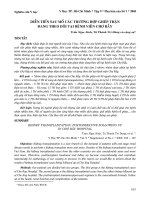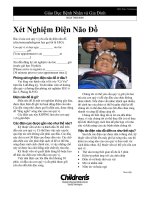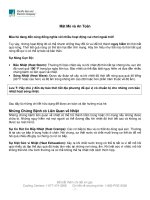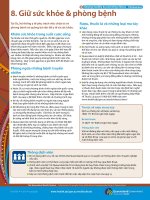Polymer nanocomposites pdf
Bạn đang xem bản rút gọn của tài liệu. Xem và tải ngay bản đầy đủ của tài liệu tại đây (5.86 MB, 613 trang )
Woodhead Publishing Ltd
Abington Hall
Abington
Cambridge CB1 6AH
England
www.woodheadpublishing.com
ISBN-13: 978-1-85573-969-7
ISBN-10: 1-85573-969-0
CRC Press LLC
6000 Broken Sound Parkway, NW
Suite 300
Boca Raton
FL 33487
USA
CRC order number WP9297
ISBN-10: 0-8493-9297-7
Polymer
nanocomposites
Edited by Yiu-Wing Mai and Zhong-Zhen Yu
Polymer nanocomposites are a class of reinforced polymers with low quantities
of nanometric-sized clay particles which give them improved barrier properties,
fire resistance and strength. Such properties have made them valuable in
components such as panels and as barrier and coating materials in automobile,
civil and electrical engineering as well as packaging. Polymer nanocomposites
provides a comprehensive review of the main types of polymer nanocomposite
and their properties.
Part I reviews the range of layered silicates and discusses such properties
as flammability and thermal stability, barrier properties, wear resistance and
biodegradability. Part II considers nanotubes, nanoparticles and inorganic–
organic hybrid systems, and analyses elasticity and strength as well as magnetic
and light-emitting properties.
With its distinguished editors and international team of contributors,
Polymer
nanocomposites will be a standard reference on this important new range of
materials for research and development managers in such sectors as automotive
and civil engineering.
Professor Yiu-Wing Mai is University Professor, Australian Federation Fellow
and Director of the Centre for Advanced Materials Technology at the University
of Sydney, Australia. Dr Zhong-Zhen Yu is Australian Postdoctoral Fellow in the
Centre for Advanced Materials Technology at the University of Sydney, Australia.
Polymer nanocomposites
Mai and Yu
Woodhead Publishing and Maney Publishing
on behalf of
The Institute of Materials, Minerals & Mining
240 x 159 /Pantone 2756 & 423
3
m
I
The Institute of Materials, Minerals & Mining
38mm
Polymer nanocomposites
Related titles:
Lightweight ballistic composites for military and law-enforcement applications
(ISBN-13: 978-1-85573-941-3; ISBN-10: 1-85573-941-0)
Ballistic composites are materials with superior properties being lightweight and durable
under environmental conditions (water and chemicals) with high performance (high
strength, impact and ballistic resistance, damage tolerance). Lightweight ballistic
composites are used in a wide range of lightweight vehicles, watercraft and aircraft
armour giving high performance and lightweight protection against bullets and fragments.
They also have exceptional insulating properties in high temperature environments. This
major new book will be the first of its kind to give a comprehensive review of the current
use of lightweight ballistic composites in both military and law-enforcement applications.
Design and manufacture of textile composites
(ISBN-13: 978-1-85573-744-0; ISBN-10: 1-85573-744-2)
This book brings together the design, manufacture and applications of textile composites.
The term 'textile composites' is often used to describe a rather narrow range of materials,
based on three-dimensional reinforcements produced using specialist equipment. The
intention here though is to describe the broad range of polymer composite materials with
textile reinforcements, from woven and non-crimp commodity fabrics to 3D textiles.
Whilst attention is given to modelling of textile structures, composites manufacturing
methods and subsequent component performance, it is substantially a practical book
intended to help all those developing new products with textile composites.
Green composites: Polymer composites and the environment
(ISBN-13: 978-1-85573-739-6; ISBN-10: 1-85573-739-6)
There is an increasing movement of scientists and engineers dedicated to minimising the
environmental impact of polymer composite production. Life cycle assessment is of
paramount importance at every stage of a product's life, from initial synthesis through to
final disposal and a sustainable society needs environmentally safe materials and pro-
cessing methods. With an internationally recognised team of authors, Green composites
examines polymer composite production and explains how environmental footprints can
be diminished at every stage of the life cycle. This book is an essential guide for agri-
cultural crop producers, governmental agricultural departments, automotive companies,
composite producers and materials scientists all dedicated to the promotion and practice
of eco-friendly materials and production methods.
Details of these and other Woodhead Publishing materials books and journals, as well as
materials books from Maney Publishing, can be obtained by:
· visiting our web site at www.woodheadpublishing.com
· contacting Customer Services (e-mail: ; fax: +44 (0)
1223 893694; tel.: +44 (0) 1223 891358 ext. 30; address: Woodhead Publishing
Limited, Abington Hall, Abington, Cambridge CB1 6AH, England)
If you would like to receive information on forthcoming titles, please send your address
details to: Francis Dodds (address, tel. and fax as above; email: francisd@woodhead-
publishing.com). Please confirm which subject areas you are interested in.
Maney currently publishes 16 peer-reviewed materials science and engineering journals.
For further information visit www.maney.co.uk/journals.
Polymer
nanocomposites
Edited by
Yiu-Wing Mai and Zhong-Zhen Yu
Woodhead Publishing and Maney Publishing
on behalf of
The Institute of Materials, Minerals & Mining
CRC Press
Boca Raton Boston New York Washington, DC
Woodhead Publishing Limited and Maney Publishing Limited on behalf of
The Institute of Materials, Minerals & Mining
Published by Woodhead Publishing Limited, Abington Hall, Abington,
Cambridge CB1 6AH, England
www.woodheadpublishing.com
Published in North America by CRC Press LLC, 6000 Broken Sound Parkway, NW,
Suite 300, Boca Raton, FL 33487, USA
First published 2006, Woodhead Publishing Limited and CRC Press LLC
ß Woodhead Publishing Limited, 2006
The authors have asserted their moral rights.
This book contains information obtained from authentic and highly regarded sources.
Reprinted material is quoted with permission, and sources are indicated. Reasonable
efforts have been made to publish reliable data and information, but the authors and
the publishers cannot assume responsibility for the validity of all materials. Neither the
authors nor the publishers, nor anyone else associated with this publication, shall be
liable for any loss, damage or liability directly or indirectly caused or alleged to be
caused by this book.
Neither this book nor any part may be reproduced or transmitted in any form or by
any means, electronic or mechanical, including photocopying, microfilming and
recording, or by any information storage or retrieval system, without permission in
writing from Woodhead Publishing Limited.
The consent of Woodhead Publishing Limited does not extend to copying for general
distribution, for promotion, for creating new works, or for resale. Specific permission
must be obtained in writing from Woodhead Publishing Limited for such copying.
Trademark notice: Product or corporate names may be trademarks or registered
trademarks, and are used only for identification and explanation, without intent to
infringe.
British Library Cataloguing in Publication Data
A catalogue record for this book is available from the British Library.
Library of Congress Cataloging in Publication Data
A catalog record for this book is available from the Library of Congress.
Woodhead Publishing Limited ISBN-13: 978-1-85573-969-7 (book)
Woodhead Publishing Limited ISBN-10: 1-85573-969-0 (book)
Woodhead Publishing Limited ISBN-13: 978-1-84569-112-7 (e-book)
Woodhead Publishing Limited ISBN-10: 1-84569-112-1 (e-book)
CRC Press ISBN-10: 0-8493-9297-7
CRC Press order number: WP9297
The publishers' policy is to use permanent paper from mills that operate a sustainable
forestry policy, and which has been manufactured from pulp which is processed using
acid-free and elementary chlorine-free practices. Furthermore, the publishers ensure
that the text paper and cover board used have met acceptable environmental
accreditation standards.
Project managed by Macfarlane Production Services, Dunstable, Bedfordshire
()
Typeset by Godiva Publishing Services Ltd, Coventry, West Midlands
Printed by TJ International Limited, Padstow, Cornwall, England
Contributor contact details xiii
Preface xvii
Part I Layered silicates
1 Polyamide/clay nanocomposites 3
MKATO and A USUKI, Toyota Central R&D Labs Inc., Japan
1.1 Introduction 3
1.2 Nylon 6-clay hybrid (NCH) 4
1.3 Synthesis of nylon 6-clay hybrid (NCH) 4
1.4 Characterization of NCH 6
1.5 Crystal structure of NCH (Kojima, 1995) 12
1.6 Properties of NCH (Kojima, 1993a) 19
1.7 Synthesizing NCH using different types of clay (Usuki, 1995) 21
1.8 Improving the synthesis method of NCH 23
1.9 Other types of nylon 24
1.10 Conclusions 26
1.11 Future trends 27
1.12 References 27
2 Epoxy nanocomposites based on layered silicates
and other nanostructured fillers 29
OBECKER and G P SIMON, Monash University, Australia
2.1 Introduction 29
2.2 Epoxy-layered silicate nanocomposites 31
2.3 Epoxy-nanocomposites based on other nanofillers 47
2.4 Ternary epoxy nanocomposite systems 48
2.5 Future trends 53
2.6 References 54
Contents
3 Bio degradable polymer/layered silicate
nanocomposites 57
S SI N H A RA Y and M BO U S M I N A , Laval University, Canada
3.1 Introduction 57
3.2 Definition and categories of biodegradable polymers 58
3.3 Properties and drawbacks of biodegradable polymers 59
3.4 Polymer/layered silicate nanocomposite technology 59
3.5 Structure and properties of layered silicates 62
3.6 Techniques used for the characterization of nanocomposites 63
3.7 Biodegradable polymers and their nanocomposites 64
3.8 Properties 86
3.9 Biodegradability 101
3.10 Melt rheology and structure-property relationship 106
3.11 Foam processing of biodegradable nanocomposites 115
3.12 Conclusions 117
3.13 Acknowledgements 119
3.14 References 119
4 Polypropylene layered silicate nanocomposites 130
K JA Y A R A M A N and S KU M A R , Michigan State University,
USA
4.1 Introduction 130
4.2 Chemical compatibilization and compounding 131
4.3 Nanostructure 134
4.4 Performance 142
4.5 Conclusions 147
4.6 Acknowledgments 147
4.7 References 147
5 Polystyrene/clay nanocomposites 151
D-R YE I , H-K FU and F-C CH A N G , National Chiao-Tung
University, Taiwan
5.1 Introduction 151
5.2 Organically modified clay 152
5.3 Surface-initiated polymerization (SIP) 155
5.4 Syndiotactic polystyrene (s-PS)/clay nanocomposite 160
5.5 Properties of nanocomposites 163
5.6 Conclusions 169
5.7 References 169
vi Contents
6 Poly(ethyl acrylate)/bentonite nanocomposites 172
T TA N G , X TO N G , Z FE N G and B HU A N G , Chinese
Academy of Sciences, People's Republic of China
6.1 Introduction 172
6.2 Materials and characterization 174
6.3 Synthesis of PEA/bentonite nanocomposites through in situ
emulsion polymerization 175
6.4 Preparation and microstructure of casting-film of PEA/ bentonite
nanocomposites from emulsion 176
6.5 Performance of PEA/bentonite nanocomposites 179
6.6 Conclusions and future trends 184
6.7 Acknowledgments 185
6.8 References 186
7 Clay-acrylate nanocomposite photopolymers 188
C DE C K E R , Universite de Haute-Alsace, France
7.1 Introduction 188
7.2 Synthesis of clay-acrylate nanocomposites 190
7.3 Properties of clay-acrylic nanocomposites 195
7.4 Conclusions 202
7.5 References 203
8 Nano comp osites based on water soluble polymers
and unmodified smectite clays 20 6
K E ST R A W H E C K E R , Veeco Instruments Inc, USA and
E M
A N I A S , The Pennsylvania State University, USA
8.1 Introduction 206
8.2 Dispersion of Na
+
montmorillonite in water soluble polymers 207
8.3 Crystallization behavior 211
8.4 Overview of nanocomposite structure and crystallization
behavior 221
8.5 Materials properties of poly(vinyl alcohol)/Na
+
montmorillonite
nanocomposites 222
8.6 Conclusions 231
8.7 References 231
9 Poly(butylene terephthlate) (PBT) based
nanocomposites 234
C-S HA , Pusan National University, Korea
9.1 Introduction 234
9.2 Impact modification of PBT by blending 235
Contents vii
9.3 PBT/organoclay nanocomposite 239
9.4 EVA/organoclay nanocomposite 242
9.5 PBT/EVA-g-MAH/organoc lay ternary nanocomposite 247
9.6 Conclusions 251
9.7 Acknowledgments 254
9.8 References 254
10 Flammability and thermal stability of polymer/
layered silicate nanocomposites 256
M ZA N E T T I , University of Turin, Italy
10.1 Introduction 256
10.2 Nanocomposites and fire 257
10.3 Flame retardant mechanism 257
10.4 Nanocomposites and conventional flame retardants 265
10.5 Conclusion and future trends 267
10.6 References 268
11 Barrier properties of polymer/clay nanocomposites 273
A SO R R E N T I N O , G GO R R A S I , M TO R T O R A and
V V
I T T O R I A , University of Salerno, Italy
11.1 Introduction 273
11.2 Background on polymer barrier properties 273
11.3 Experimental methods 277
11.4 Permeation and diffusion models relevant to polymer
nanocomposites 279
11.5 Polymer nanocomposites diffusivity 282
11.6 Polymer nanocomposites sorption 286
11.7 Polymer nanocomposites permeability 287
11.8 Conclusions and future trends 291
11.9 References 292
12 Rubber-clay nanocomposites 297
A MO H A M M A D and G P SI M O N , Monash University, Australia
12.1 Introduction 297
12.2 Overview of rubbers (elastomers) 297
12.3 Fillers predominantly used in the rubber industry 302
12.4 Rubber crosslinking systems 304
12.5 Types of rubber-clay nanocomposite structure 305
12.6
Comparison of properties achieved in rubber-clay nanocomposites
317
12.7 Conclusions 321
12.8 References 322
viii Contents
Part II Nanotubes, nanoparticles and inorganic-organic hybrid
systems
13 Single-walled carbon nanotubes in epoxy
composites 329
K LI A O and Y RE N , Nanyang Technological University,
Singapore and T X
I A O , Shantou University, People's
Republic of China
13.1 Introduction 329
13.2 Mechanical properties: elastic properties and strength 331
13.3 Carbon nanotube ± polymer interface 337
13.4 Long-term performance of unidirectional CNT/epoxy
composites 346
13.5 Conclusions 353
13.6 References 354
14 Fullerene/carbon nanotube (CNT) composites 35 9
T KU Z U M A K I , The University of Tokyo, Japan
14.1 Introduction 359
14.2 Fabrication of the composite by the drawing process 362
14.3 Fabrication of the composite by ultra high-pressure sintering 372
14.4 Application potential 378
14.5 Conclusions 386
14.6 References 386
15 Filled polymer nanocompo sites containing
functionalized nanoparticles 389
O OK PA R K , J H PA R K and T-H KI M , Korea Advanced
Institute of Science and Technology, Korea and Y T L
I M ,
Korea Research Institute of Bioscience and Biotechnology,
Korea
15.1 Introduction 389
15.2 Organic and polymer materials for light-emitting diodes 389
15.3 Luminescent polymer for device applications 391
15.4 Photo-oxidation of emitting polymers 393
15.5 Nanoparticles approaches to enhance the lifetime of emitting
polymers 396
15.6 Conclusions and future trends 409
15.7 References 409
Contents ix
16 Polymer/calcium carbonate nanocomposites 412
X LU , Nanyang Technological University, Republic of
Singapore and T L
I U , Institute of Advanced Materials,
People's Republic of China
16.1 Introduction 412
16.2 Preparation and surface modification of nano-CaCO
3
413
16.3 Fabrication of polymer/CaCO
3
nanocomposites 417
16.4 Characterization 420
16.5 Applications 433
16.6 Conclusion and future trends 434
16.7 References 435
17 Magnetic polymer nanocomposites 440
A MI L L A N and F PA L A C I O , University of Zaragoza, Spain
and E S
N O E C K , V SE R I N and P LE C A N T E , CEMES-CNRS,
France
17.1 Introduction 440
17.2 Classification of magnetic polymer nanocomposites 442
17.3 Synthesis 447
17.4 Characterization 455
17.5 Magnetic properties 466
17.6 Future trends 470
17.7 References 471
18 Phenolic resin/SiO
2
organic-inorganic hybrid
nanocomposites 485
C-L CH I A N G , Hung-Kuang University, Taiwan and
C-C M M
A , National Tsing-Hua University, Taiwan
18.1 Introduction 485
18.2 Experimental 487
18.3 Results when IPTS was used as a coupling agent 493
18.4 Results when GPTS was used as a coupling agent 500
18.5 Conclusions 506
18.6 References 507
19 Polymer/graphite nanocomposites 510
Y ME N G , Sun Yat-Sen University, People's Republic of China
19.1 Introduction 510
19.2 Features of graphite 511
19.3 Structures of polymer/graphite nanocomposites 519
19.4 Preparations of polymer/graphite nanocomposites 520
x Contents
19.5 Properties 529
19.6 Conclusions 532
19.7 Acknowledgments 533
19.8 References 533
20 Wear resisting polymer nanocomposites:
preparation and properties 540
M Q ZH A N G and M Z RO N G , Zhongshan University, People's
Republic of China and K F
R I E D R I C H , Institute for Composite
Materials (IVW), Germany
20.1 Introduction 540
20.2 Surface treatment 542
20.3 Composites manufacturing 548
20.4 Wear performance and mechanisms 558
20.5 Conclusions and future trends 568
20.6 Acknowledgements 570
20.7 References 570
Index 578
Contents xi
(* = main contact)
Chapter 1
Makoto Kato* and Dr Arimitsu
Usuki
41-1 Yokomichi
Nagakute
Nagakute-Cho
Aichi-Gun
Aichi 480-1192
Japan
Tel: +81-561-63-5252
Email: ;
jp
Chapter 2
Dr Ole Becker*
Airbus Deutschland GmbH
Cabin Supply Systems ± BCEBS
Kreetslag 10
21129 Hamburg
Germany
Email:
Professor George Simon
School of Physics & Materials
Engineering
Monash University
Melbourne
Victoria 3800
Australia
Email:
Chapter 3
Dr Suprakas Sinha Ray* and
Mosto Bousmina
Department of Chemical Engineering
Laval University
Sainte-Foy
Quebec G1K 7P4
Canada
Tel.: +1 418 656 2131 Ext. 8368
Fax: +1 418 656 5993
Email: ;
Chapter 4
Professor Krishnamurthy Jayaraman*
and Dr Sharad Kumar
Department of Chemical Engineering
and Materials Science
2527 Eng. Bldg
Michigan State University
East Lansing
MI 48824
USA
Tel: 517 355-5138; 517 432-1105
Email:
Contributor contact d etails
Chapter 5
Ding-Ru Yei, Huei-Kuan Fu and
Professor Feng-Chih Chang
Institute of Applied Chemistry
National Chiao-Tung University
Hsin-Chu 30050
Taiwan
Tel: 886-3-5727077
Email:
Chapter 6
Professor Tao Tang, Xin Tong,
Zhiliu Feng and B Huang
State Key Laboratory of Polymer
Physics and Chemistry
Changchun Institute of Applied
Chemistry
Chinese Academy of Sciences
Changchun 130022
People's Republic of China
Tel: 0086-0431-5685653
Email:
Chapter 7
Professor Christian Decker
DeÂpartement de Photochimie
GeÂneÂrale (UMR-CNRS N7525)
Ecole Nationale SupeÂrieure de
Chimie de Mulhouse
Universite de Haute-Alsace
3, rue Werner
68200 Mulhouse
France
Email:
Chapter 8
Dr Kenneth E Strawhecker*
Veeco Instruments Inc
112 Robin Hill Road
Santa Barbara
CA 93117
USA
Email:
Evangelos Manias
Department of Materials Science and
Engineering
The Pennsylvania State University
University Park
PA 16801
USA
Chapter 9
Professor Chang-Sik Ha
Department of Polymer Science and
Engineering
Pusan National University
Pusan 609-735
Korea
Tel: +82/51-510-2407
Email:
Chapter 10
Marco Zanetti
Dipartimento di Chimica Inorganica
Fisica e dei Materiali and
Nanostructured Interfaces and
Surfaces Centre of Excellence
UniversitaÁ degli Studi di Torino
Via Pietro Giuria, 7
I-10125, Torino
Italy
Email:
Chapter 11
Professor Vittoria Vittoria*, Dr
Andrea Sorrentino, Dr Giuliana
Gorrasi, Dr Mariarosaria Tortora
Chemical and Food Engineering
Department
University of Salerno
xiv Contributor contact details
via Ponte Don Melillo
I-84084 Fisciano ± Salerno
Italy
Tel.: +39 089 96 4114/4019
Fax: +39 089 96 4057
Email:
Chapter 12
Professor George Simon* and
Abubaker Mohammad
Department of Materials Engineering
Monash University
Melbourne
Victoria 3800
Australia
Email:
Chapter 13
Associate Professor Kin Liao*
School of Chemical and Biomedical
Engineering,
Nanyang Technological University
50 Nanyang Avenue
Singapore 639798
Email:
Yu Ren
School of Mechanical and Aerospace
Engineering
Nanyang Technological University
50 Nanyang Avenue
Singapore 639798
Tan Xiao
Department of Physics
Shantou University
Shantou 515063
People's Republic of China
Chapter 14
Professor Toru Kuzumaki
Institute of Industrial Science
The University of Tokyo
4-6-1 Komaba
Meguro-ku
Tokyo 153 8505
Japan
Tel: +81 (3) 5452 6302
Fax: +81 (3) 5452 6301
Email:
Chapter 15
Professor O Ok Park*, Jong Hyeok
Park, Tae-Ho Kim
Department of Chemical &
Biomolecular Engineering
Korea Advanced Institute of Science
and Technology
373-1 Guseong-dong
Yuseong-gu
Daejeon, 305-701
Korea
Tel: +82-42-869-3923
Email:
Chapter 16
Dr Xuehong Lu*
School of Materials Science &
Engineering
Nanyang Technological University
Nanyang Avenue
Singapore 639798
Email:
Dr Tianxi Liu
Institute of Advanced Materials
Fudan University
220 Handan Road
Shanghai 200433
People's Republic of China
Email:
Contributor contact details xv
Chapter 17
Professor Angel Millan* and
Fernando Palacio
Instituto de Ciencia de Materiales de
AragoÂn
CSIC-Universidad de Zaragoza
Facultad de Ciencias
c/ Pedro Cerbuna 12
50009 Zaragoza
Spain
Email:
Etienne Snoeck, Virginie Serin and
Pierre Lecante
CEMES-CNRS
29 rue Jeanne Marvig
F-31055 Toulouse Cedex
France
Chapter 18
Dr Chin-lung Chiang
Department of Industrial Safety and
Health
Hung-Kuang University
Sha-Lu
Taiwan, 433
Republic of China
Tel: 886-426318652-2250
Email:
Professor Chen-Chi M. Ma*
Department of Chemical Engineering
National Tsing-Hua University
Hsin-Chu
Taiwan, 30043
Republic of China
Email:
Chapter 19
Professor Yuezhong Meng
Institute of Energy & Environmental
Materials
School of Physics & Engineering
Sun Yat-Sen University
Guangzhou 510275
People's Republic of China
Tel/Fax: +8620-84114113
Email:
Chapter 20
Professor Ming Qiu Zhang*
Materials Science Institute
Zhongshan University
Guangzhou 510275
People's Republic of China
Tel/Fax: +86-20-84036576
Email:
Min Zhi Rong
Key Laboratory for Polymeric
Composite and Functional
Materials of Ministry of Education
Zhongshan University
Guangzhou 510275
People's Republic of China
Klaus Friedrich
Institute for Composite Materials
(IVW)
University of Kaiserslautern
D-67663 Kaiserslautern
Germany
xvi Contributor contact details
Polymer nanocomposites are commonly defined as the combination of a
polymer matrix and additives that have at least one dimension in the nanometer
range. The additives can be one-dimensional (examples include nanotubes and
fibres), two-dimensional (which include layered minerals like clay), or three-
dimensional (including spherical particles). Over the past decade, polymer
nanocomposites have attracted considerable interests in both academia and
industry, owing to their outstanding mechanical properties like elastic stiffness
and strength with only a small amount of the nanoadditives. This is caused by
the large surface area to volume ratio of nanoadditives when compared to the
micro- and macro-additives. Other superior properties of polymer nano-
composites include barrier resistance, flame retardancy, scratch/wear resistance,
as well as optical, magnetic and electrical properties.
This book covers both fundamental and applied research associated with
polymer-based nanocomposites, and presents possible directions for further
development of high performanc e nanocomposites. It has two main parts. Part I
has 12 chapters which are entirely dedicated to those polymer nanocomposites
containing layered silicates (clay) as a n additive. Many thermoplastics,
thermosets, and elastomers are included, such as polyamide (Chapter 1), poly-
propylene (Chapter 4), polystyrene (Chapter 5), poly(butylene terephthalate)
(Chapter 9), poly(ethyl acrylate) (Chapter 6), epoxy resin (Chapter 2),
biodegradable polymers (Chapter 3), water soluble polymers (Chapter 8),
acrylate photopolymers (Chapter 7) and rubbers (Chapter 12). In addition to
synthesis and structural characterisation of polymer/clay nanocomposites, their
unique physical properties like flame retardancy (Chapter 10) and gas/liquid
barrier (Chapter 11) properties are also discussed. Furthermore, the
crystallisation behaviour of polymer/clay nanocomposites and the significance
of chemical compatibility between a polymer and clay in affecting clay
dispersion are also considered.
Part II of this book deals with the most recent developments of polymer
nanocomposites with other nanoadditives such as carbon nanotubes, graphite,
nanoparticles and other inorganic±organic hybrid systems and has eight
Preface
chapters. Carbon nanotubes, since their discovery in 1991, have attracted a great
deal of attention because of their exceptio nal elastic modulus, bending strength,
aspect ratio, electrical and thermal conductivity, chemical and thermal stability,
and adsorbabi lity. Chapters 13 and 14 are concerned with carbon nanotubes as a
means of reinforcement. The former is concerned with the mechanical properties
and long-term performance of carbon nanotube/epoxy composites; and the latter
illustrates the fabrication and potential applications of nano composites
fabricated by using carbon nanotubes as the fibre and carbon 60 crystals as
the matrix. Three chapters are entirely devoted to functional polymer nano-
composites. The design and fabrication of polymer nanocomposites filled with
functional nanopa rticles for specific functional properties (Chapter 15), the
synthesis and characterisation of magnetic polymer nanocomposites (Chapter
17), and the conducting polymer/graphite nanocomposites (Chapter 19) are
discussed. The wear characteristics of polymer nanocomposites reinforced with
different nanoparticles are studied in Chapter 20. The effect of different surface
treatment techniques of nanoparticles on the wear behaviour is investigated. In
addition, the latest progress on surface modification of CaCO
3
nanoparticles and
their polymer nanocomposites in terms of toughening and reinforcement is given
in Chapter 16. Phenolic resin/silica nanocomposites synthesised by sol-gel
techniques are described in Chapter 18.
We would like to express our sincerest appreciation to all the authors for their
valuable contributions and the referees for their critical evaluations of the
manuscripts. Our special thanks go to Francis Dodds, Gwen Jones, Melanie
Cotterell and Emma Pearce at Woodhead Publishing Limited, as well as
Amanda Macfarlane at Macfarlane Production Services for their cooperation,
suggestions and advice during the various phases of preparation, organisation
and production of the book.
Yiu-Wing Mai
Zhong-Zhen Yu
Sydney, Australia
xviii Preface
Part I
Layered silicates
1.1 Introduction
A typical polymer composite is a combination of a polymer and a filler. Because
compounding is a technique that can ameliorate the drawbacks of conventional
polymers, it has been studied over a long period and its practical applications are
well known. Reinforcing materials such as `short-fiber' are often used for
compounding with thermoplastic polymers in order to improve their mechanical
or thermal properties. Polyamide (nylon) is a thermoplastic polymer, and glass
fiber and carbon fiber are used mainly as reinforcing materials. A filler, typically
micron-sized, i s incorporated into composite materials to improve their
properties. The polymer matrix and the fillers are bonded to each other by
weak intermolecular forces, and chemical bonding is rarely involved. If the
reinforcing material in the composite could be dispersed on a molecular scale
(nanometer level) and interacted with the matrix by chemical bonding, then
significant improvements in the mechanical properties of the material or
unexpected new properties might be realized. These are the general goals of
polymer nanocomposite studies. In order to achieve this purpose, clay minerals
(montmorillonite, saponite, hectorite, etc.) have been discussed as candidates for
the filler material. A layer of silicate clay mineral is about 1 nm in thickness and
consists of platelets of around 100 nm in width, so it represents a filler with a
significantly large aspect ratio. For comparison, a glass fiber 13 "m in diameter
with a length of 0.3 mm is 4 Â 10
9
times the size of a typical silicate layer. In
other words, if the same volumes of glass fiber and silicate were evenly
dispersed, there would be a roughly 10
9
-fold exces s of silicate layers, with an
exponentially higher specific surface area available.
A nylon 6-clay hybrid (nanocomposite, NCH:
Nylon 6-Clay Hybrid) was
originally developed by Usuki and his colleagues and was the first polymer
nanocomposite to be used practically. Since 1990 when it was first used, various
studies and analyses have been reported. In this chapter, details of the NCH and
other nylon-clay nanocomposites will be described.
1
Polyamide/clay nanocomposites
M K A T O and A U S U K I , Toyota Central R&D Labs Inc., Japan
1.2 Nylon 6-clay hybrid (NCH)
Nylon 6-clay hybrid (NCH) is synthesized by the `monomer intercalation'
method, in which clay is first ion-exchanged using an organic compound in
order for the monomer to intercalate into the layers of the clay. The monomers
that form the intercalated layer become a polymerized interlayer. The basic
concept of the technique is as follows. Nylon 6 is produced by the ring-opening
polymerization of -caprolactam. This can occur in the presence of clay, after -
caprolactam intercalates into a clay gallery so that the silicate layers are
dispersed uniformly in the nylon 6 matrix. Usuki and his colleagues found that
organophilic clay that had been ion-exchanged with 12-aminododecanoic acid
could be swollen by molten -caprolactam (the basal spacing expanded from
1.7 nm to 3.5 nm) (Usuki, 1993a). -caprolactam was then polymerized in the
clay gallery and the silic ate layers were dispersed in nylon 6 to yield a nylon 6-
clay hybrid (NCH) (Usuki, 1993b). This is the first example of an industrial
clay-based polymer nanocomposite. Figure 1.1 shows a schematic representation
of the polymerization.
The modulus of NCH increased to 1.5 times that of nylon 6, the heat
distortion temperature increased to 140ëC from 65ëC, and the gas barrier effect
was doubled at a low loading (2 wt.%) of clay (Kojima, 1993a).
1.3 Synthesis of nylon 6-clay hybrid (NCH)
1.3.1 Clay organization and monomer swelling (Usuki, 1993a)
If montmorillonite containing sodium ions between its layers is dispersed in
water, its silicate layers swell uniformly. If an alkylammonium salt is added to
this aqueous mixture, the alkylammonium ions are exchanged with the sodium
ions. As a result of this exchange reaction, an organophilic clay forms, in which
the alky lammonium ions are intercalated between the layers. Because the
silicate layers in the clay are negatively charged, they form ionic bonds with the
1.1 Schematic diagram of polymerization to NCH.
4 Polymer nanocomposites
intercalated alkylammonium ions. By changing the length and type of alkyl
chain, the hydrophilic/hydrophobic and other characteristics of this organophilic
clay can be adjusted such that surface modification of the clay becomes
possible.
A novel compounding technique was developed to synthesize nylon 6 in a
clay gallery by modifying the clay surface and intercalating monomers into the
gallery. The organophilic material used in this technique must satisfy the
following three requirements:
1. It must have an ammonium ion at one end of the chain so that it can interact
with clay through ionic bonding.
2. It must have a carboxylic acid group (±COOH) at the other end to react with
-caprolactam, a nylon 6 monomer, for ring opening and polymerization.
3. It must possess intermediate polarity to enable -caprolactam to intercalate
among silicate layers.
It was found that 12-aminododecanoic acid (H
2
N(CH
2
)
11
COOH) met all of these
requirements.
A repre sentative method for making organophilic c lay by using 12-
aminododecanoic acid and the method of swelling organophilic clay by -
caprolactam will now be described.
Using a homomixer, 300 g of montmorillonite were uniformly dispersed in 9
liters of deionized water at 80ëC. 154 g of 12-aminododecanoic acid and 72 g of
concentrated hydrochloric acid were dissolved in 2 liters of deionized water at
80ëC. This solution was mixed with the montmorillonite dispersion and stirred
for five minutes. The mixture was filtered to obtain aggregates, which were
washed twice with water at 80ëC and freeze-dried. In this way, organophilic clay
was obtained in the form of a fine white powder, called `12-Mt'.
12-Mt and -caprolact am in a weight ratio of 1:4 were mixed thoroughly in a
mortar, and then dried and dehydrated for 12 hours in a vacuum desiccator
containing phosphorous pentoxide. These specimens were left in a temperature-
controlled bath at 100ëC for one hour to be swollen by -caprolactam. They were
then subjected to X-ray diffraction measurements at 25ëC and 100ëC. It was
found that two distinct spacings were present at the different temperatures:
3.15 nm (25ëC) and 3.87 nm (100ëC) and that the specimen processed at 100ëC
had caprolactam molecules intercalated between the layers.
1.3.2 Synthesizing the nylon-clay nanocomposite (Usuki,
1993b)
A typical synthesis method of NCH containing 5 wt.% of 12-Mt is described
below. Amounts of 509 g of -caprolactam, 29.7 g of 12-Mt (with about 300 g of
water), and 66 g of 6-aminocaproic acid were put in a 3 liter separable flask with
stirrers, and were degassed using nitrogen. These flasks were then immersed in
Polyamide/clay nanocomposites 5
an oil bath and stirred at 250ëC with nitrogen gas flow for 6 hours to polymerize
the -caprolactam. Water overflowed the flasks due to distillation halfway
through this process. Polymeriz ation was terminated when the load on the
stirrers increased to a certain level.
After the flasks were cooled, aggregated polymers were removed from the
flasks and pulverized. They were then washed with water at 80ëC three times to
remove any monomers and oligomers that remained unreacted. Finally, the
aggregates were dried for 12 hours at 80ëC in a vacuum to obtain NCH. In this
chapter, the loadings of 12-Mt are expressed in wt.%, and NCHs with different
loadings of 12-Mt are called NCH2, NCH5, NCH70 (and so on) for 2, 5 and
70 wt.%, respectively.
1.4 Characterization of NCH
Figure 1.2 shows various X-ray diffraction spectra. With NCH70 and NCH50, a
clear peak showing the interlayer distance associated with the d (001) plane of
montmorillonite was observed. With NCH30 and NCH15, however, the peak
was weak and took the form of a shoulder. With NCH2, NCH5 and NCH8, no
peak was observed in the measurement range. The inflection point of each
shoulder-shaped feature was defined as the peak of d (001), in order to calculate
the interlayer distance. These results are shown in Table 1.1.
Figure 1.3 shows the surfaces of pres s-molded NCH and NCC products. NCC
was a composite material prepared by melting and kneading sodium-type
montmorillonite (unorganized type) and nylon 6 using a twin-screw extruder at
250ëC for the purpose of comparing with NCH. The surface of the press-molded
NCH product was smooth, whereas many millimeter-scale aggregates of clay
minerals were seen on the surface of the press-molded NCC product. Further-
more, many bubbles were observed during the molding of the press-molded
NCC product. This was thought to be an effect of water contained in the sodium-
type montmorillonite.
Table 1.1 Basal spacing of NCHs
Content of clay (wt.%) Basal spacing from XRD
NCH2 1.5 ö
NCH5 3.9 ö
NCH8 6.8 ö
NCH15 13.0 12.1
NCH30 26.2 6.0
NCH50 42.8 4.4
NCH70 59.6 2.6
12-Mt 78.7 1.7
Nylon 6 0 ö
6 Polymer nanocomposites









